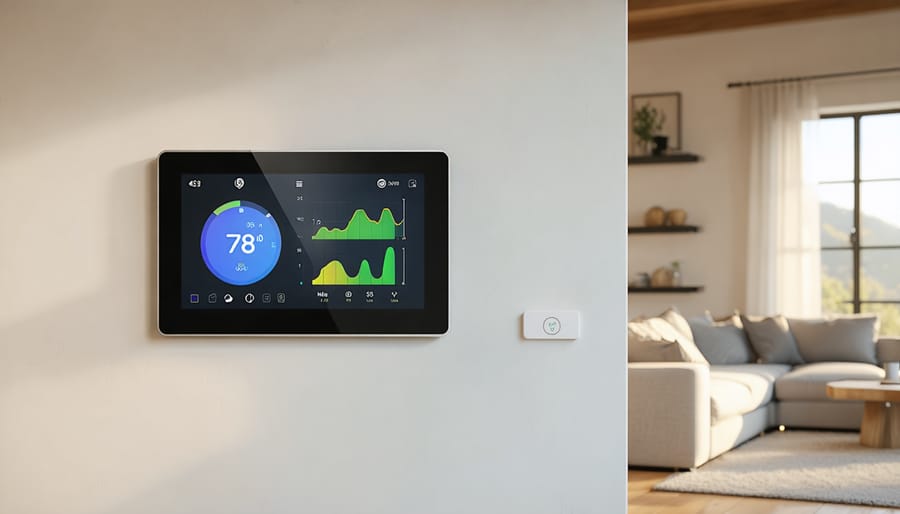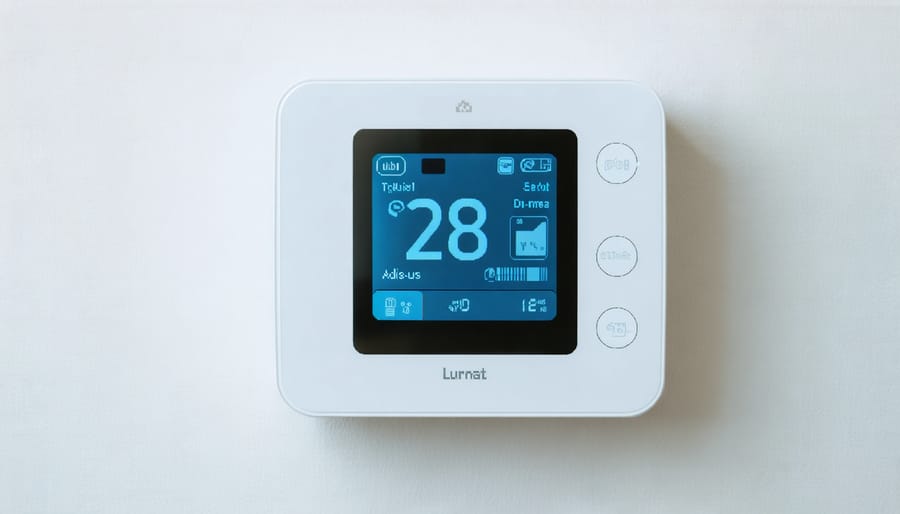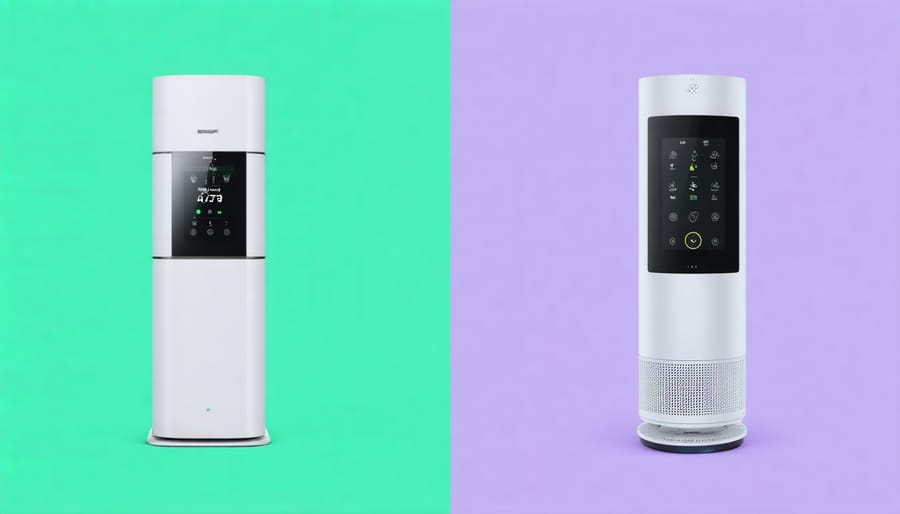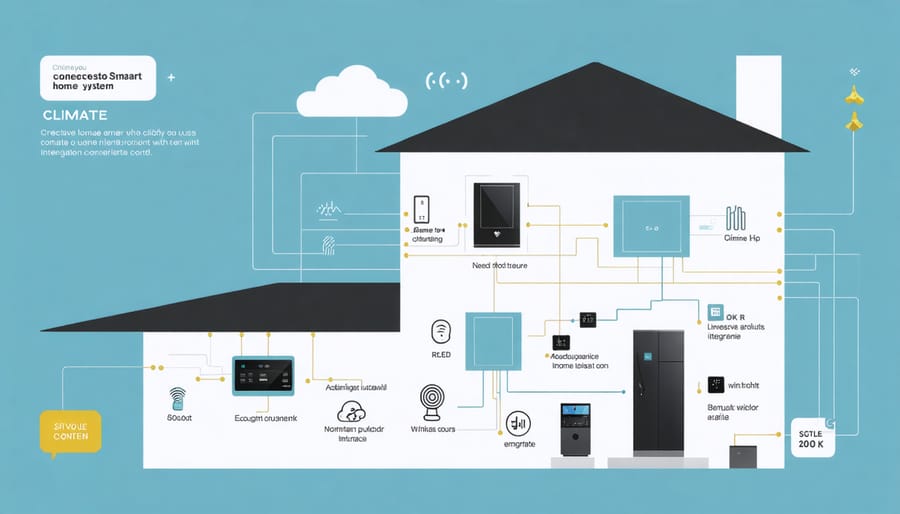
Smart Climate Control That Actually Saves You Money (And How It Works)
Transform your home’s climate control into an intelligent, energy-saving ecosystem with today’s smart technology. Modern smart thermostats and integrated HVAC systems learn your preferences, automatically adjust to your schedule, and cut energy costs by up to 23% while maintaining perfect comfort levels throughout your home.
Gone are the days of wrestling with complicated programming or coming home to an uncomfortable house. Smart climate systems now offer voice control, smartphone integration, and AI-powered optimization that anticipates your needs before you even think about adjusting the temperature. Zone-based control lets you customize different areas of your home, while advanced sensors monitor humidity, air quality, and occupancy to create the ideal environment.
For homeowners looking to upgrade, smart climate control represents more than just convenience – it’s an investment that pays for itself through reduced energy bills, extended equipment life, and enhanced property value. Whether you’re building new or retrofitting an existing system, today’s smart solutions seamlessly integrate with other home automation features to deliver unprecedented control over your indoor environment.
How Smart Climate Control Transforms Your Home Comfort
Beyond Basic Thermostats: Key Features That Matter
Modern smart thermostats go far beyond simple temperature control, offering features that transform how we manage our home’s climate. One of the most significant advancements is zone control systems, which allow you to set different temperatures for various areas of your home. This means you can keep the bedroom cool while maintaining a warmer living room, maximizing both comfort and efficiency.
Learning capabilities are another game-changing feature. Smart thermostats observe your daily routines and temperature preferences, automatically adjusting settings to create the perfect environment. They can detect when you’re home, away, or sleeping, optimizing temperature controls accordingly. Some models even factor in local weather forecasts to make proactive adjustments.
Remote access has become a must-have feature, letting you control your home’s climate from anywhere using your smartphone. Forgot to adjust the temperature before leaving for vacation? No problem – just open the app and make changes on the fly. Many systems also send alerts about unusual temperature changes or when it’s time to change your air filter.
Voice control integration with platforms like Alexa or Google Assistant makes adjusting your home’s climate as simple as saying “Hey Google, set the temperature to 72 degrees.” Plus, smart thermostats provide detailed energy usage reports, helping you identify patterns and opportunities for savings. Some even offer suggestions for optimizing your settings based on your energy consumption data, making it easier than ever to maintain comfort while reducing utility bills.

Real Energy Savings: The Numbers Behind Smart Climate Control
When it comes to smart climate control, the numbers tell a compelling story. Homeowners who upgrade to AI-powered climate solutions typically see energy savings between 10-30% on their heating and cooling costs.
Let’s break down these savings with a real-world example: For a 2,000-square-foot home with an average monthly energy bill of $200, smart climate control can reduce costs by $20-60 per month. That’s up to $720 in annual savings! These figures account for both the automated temperature adjustments and the system’s ability to learn and optimize your home’s heating and cooling patterns.
The savings become even more impressive when you factor in peak-hour energy management. Smart thermostats can automatically adjust your home’s temperature during high-rate periods, potentially saving an additional 5-15% on energy costs. For instance, pre-cooling your home before peak afternoon rates kick in can significantly reduce your air conditioning expenses during summer months.
Zone-based climate control adds another layer of efficiency. By heating or cooling only occupied rooms, homeowners report saving an additional 20% on their energy bills. A family that primarily uses their living areas during the day and bedrooms at night can dramatically reduce energy waste by implementing smart zoning.
The initial investment in smart climate control typically pays for itself within 12-18 months through these combined savings. Plus, many utility companies offer rebates ranging from $50 to $100 for installing qualified smart thermostats, making the upgrade even more attractive from a financial perspective.
Setting Up Your Smart Climate System
Choose Your System: Popular Options Compared
When it comes to smart climate control systems, several standout options offer unique features to suit different needs and budgets. The Ecobee SmartThermostat leads the pack with its room sensors and built-in Alexa capabilities, making it perfect for larger homes where temperature can vary between rooms. It learns your schedule and adjusts automatically, potentially saving up to 23% on annual energy costs.
The Nest Learning Thermostat remains a popular choice, particularly for its sleek design and intuitive interface. Its standout feature is its ability to learn your preferences within a week of normal use, creating a personalized schedule without manual programming. The device’s “Eco” mode automatically adjusts when you’re away, and its compatibility with Google Home makes voice control seamless.
For budget-conscious homeowners, the Honeywell Home T9 offers excellent value with its smart room sensors and straightforward installation process. While it may lack some premium features, it provides reliable temperature control and smartphone integration at a more accessible price point.
Looking for maximum flexibility? The Mysa Smart Thermostat specializes in electric baseboard heating control and works beautifully with both Apple HomeKit and Amazon Alexa. Its minimalist design and energy usage reports make it particularly appealing for modern homes.
Each system offers smartphone control through dedicated apps, but compatibility with your existing smart home ecosystem should be a key consideration. Consider factors like the size of your home, your heating system type, and whether you prioritize features like humidity control or advanced scheduling when making your choice.

Installation Tips for Maximum Efficiency
For the best results with your smart climate control system, proper installation is crucial. Start by choosing the ideal location for your smart thermostat – typically on an interior wall away from direct sunlight, air vents, and doorways. This ensures accurate temperature readings and optimal performance.
Before installation, turn off power to your HVAC system at the circuit breaker. Take a photo of your existing wiring configuration – this will be invaluable if you need to reference it later. Most smart thermostats come with a mounting plate and clear labeling for wire connections, making DIY installation straightforward for most homeowners.
For zoned systems, install smart vents in rooms where you want independent temperature control. Place temperature sensors at chest height in frequently used areas, avoiding spots near windows or heat-generating appliances. If your system includes humidity sensors, position them in areas where moisture control is most important, such as bathrooms or basements.
When connecting to your home’s WiFi network, ensure your router signal is strong at the thermostat location. Consider a WiFi extender if needed. Many manufacturers offer step-by-step mobile apps that guide you through the installation and initial setup process.
While DIY installation is possible for most systems, consider professional installation if you’re dealing with:
– Complex multi-zone systems
– Older HVAC equipment
– Unusual wiring configurations
– High-voltage systems
– Integration with other smart home platforms
After installation, run a complete test cycle of your heating and cooling systems to ensure everything works correctly. Take time to learn your system’s features and set up automated schedules for maximum efficiency.
Getting the Most From Your Smart Climate Control
Scheduling and Automation that Works
Setting up effective schedules and automation routines is key to getting the most from your smart climate control system and maximize energy savings. Start by establishing a basic weekly schedule that aligns with your household’s routine. Program your system to adjust temperatures during sleeping hours (typically lowering heat by 5-8 degrees) and when the house is empty during work hours.
Layer in smart triggers to fine-tune your automation. Use occupancy sensors to detect when rooms are in use, and geo-fencing to automatically adjust settings when family members are heading home. Many systems can also learn from your manual adjustments over time, creating more personalized comfort profiles.
Consider creating different zones in your home with unique schedules. Your bedroom might need cooling earlier in the evening, while your home office requires comfort during work hours. Add weather-responsive automation that adjusts based on outdoor conditions – like automatically reducing heating when it’s sunny or increasing dehumidification on muggy days.
Don’t forget to set up alerts for maintenance needs and extreme temperature variations. This proactive approach helps prevent system issues and ensures consistent comfort. Remember to review and adjust your schedules seasonally, accounting for changing daylight hours and outdoor temperatures.

Integration with Other Smart Home Devices
Modern smart home climate control systems truly shine when integrating smart home devices across your living space. Your thermostat can work seamlessly with smart blinds to naturally cool rooms during hot summer days, or coordinate with smart lighting to adjust temperature based on room occupancy. Motion sensors can trigger climate adjustments when you enter or leave specific areas, while smart door and window sensors can automatically pause your HVAC system when windows are open.
Voice assistants like Alexa or Google Home make controlling your climate system effortless – simply ask to adjust the temperature or create new comfort schedules. Smart security systems can also pitch in, automatically adjusting temperatures when you arm your system and leave for work.
For the ultimate in convenience, create automated scenes that coordinate multiple devices. A “Good Morning” scene might gradually warm your home while raising the blinds and turning on lights, while “Movie Night” could dim the lights and set the perfect viewing temperature. Smart plugs connected to portable heaters or fans can provide supplementary climate control in specific areas, all managed through a single app.
Remember that compatibility is key when choosing devices. Look for products that work with your existing smart home platform, whether it’s Apple HomeKit, Samsung SmartThings, or another ecosystem.
Smart home climate control represents a significant leap forward in home comfort and energy management. By implementing these intelligent systems, you’re not just upgrading your HVAC setup – you’re investing in a more comfortable, efficient, and environmentally conscious home. The combination of smart thermostats, zoning systems, and automated controls puts you in command of your indoor environment like never before.
The benefits are clear: reduced energy bills, customized comfort for every room, and the convenience of controlling your home’s climate from anywhere. With features like learning capabilities, occupancy sensing, and weather adaptation, these systems continually optimize your home’s environment while minimizing energy waste.
Don’t wait to transform your home into a smart climate-controlled sanctuary. Whether you’re starting small with a smart thermostat or going all-in with a comprehensive zoning system, the technology is accessible and increasingly user-friendly. Take the first step today by assessing your current setup and exploring the smart climate solutions that best fit your needs. Your comfort, wallet, and planet will thank you.
